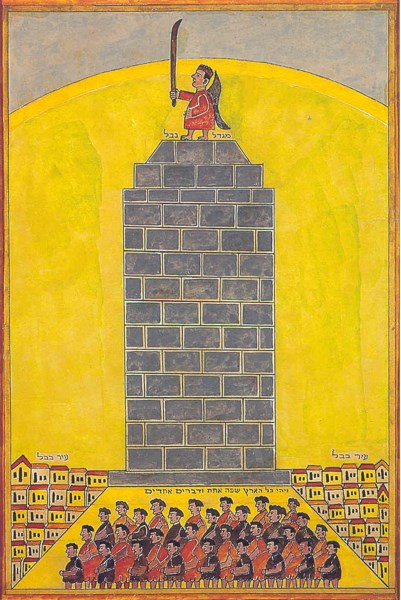Deconstructing Migdal Bavel
Introduction


The Unknowns
The first half of Bereshit 11 records the story of both man's attempt to build the city and tower of Bavel and Hashem's thwarting of this plan. There are a number of elements of the narrative which are shrouded in mystery including:
- Which people were involved? Was it the entire human race? Did any of the characters known from surrounding stories (such as Noach, Shem, Ever, Nimrod, or Avraham) play a role in the process?
- In whose time did the building commence, and how long did the entire process take? Did the abandoning of the project occur overnight, or was it the culmination of a lengthy process of linguistic diversification and evolution which spanned multiple generations or even centuries?
Human Objectives
Perhaps the most challenging issue, though, is to understand the stated purpose(s) of the project. 11:4 reads:
וַיֹּאמְרוּ הָבָה נִבְנֶה לָּנוּ עִיר וּמִגְדָּל וְרֹאשׁוֹ בַשָּׁמַיִם וְנַעֲשֶׂה לָּנוּ שֵׁם פֶּן נָפוּץ עַל פְּנֵי כׇל הָאָרֶץ.
They said, “Come, let’s build ourselves a city, and a tower whose top reaches to the sky, and let’s make ourselves a name, lest we be scattered abroad on the surface of the whole earth.”
This verse raises several questions:
- Is it possible that the people thought they could literally reach the heavens ("וְרֹאשׁוֹ בַשָּׁמַיִם"), or is this just a figure of speech for an extremely tall tower?
- Was the primary goal the building of the city ("עִיר") or the tower ("מִגְדָּל")?
- What is the relationship between reaching for the sky ("וְרֹאשׁוֹ בַשָּׁמַיִם") and making a name for themselves ("וְנַעֲשֶׂה לָּנוּ שֵׁם")?
- How would either of these twin goals prevent the dispersal of mankind ("פֶּן נָפוּץ עַל פְּנֵי כָל הָאָרֶץ") and why was this a desideratum? Did the city planners really envision that all of human civilization would be contained within the walls of one city?
Hashem's Objections
In 11:6 Hashem reacts with great concern to the human scheme:
וַיֹּאמֶר י״י הֵן עַם אֶחָד וְשָׂפָה אַחַת לְכֻלָּם וְזֶה הַחִלָּם לַעֲשׂוֹת וְעַתָּה לֹא יִבָּצֵר מֵהֶם כֹּל אֲשֶׁר יָזְמוּ לַעֲשׂוֹת.
Hashem said, “Behold, they are one people, and they have all one language, and this is what they begin to do. Now nothing will be withheld from them, which they intend to do.
But why was Hashem so troubled by the plans that He needed to actively intervene? Surely He could not have been worried that the builders would actually reach the Heavenly throne? And what is the meaning of the relationship between "וְזֶה הַחִלָּם לַעֲשׂוֹת" and "כֹּל אֲשֶׁר יָזְמוּ לַעֲשׂוֹת"? Do these refer to two stages of the same plan or to two completely different projects, and which constitutes the main problem?
The Story's Message
In addition to attempting to understand what actually transpired in the story of Migdal Bavel, the reader must try to also decipher the Torah's purpose in recounting this enigmatic episode.
- Is the Torah merely recording historical developments, is it engaging in a polemic against primitive beliefs, or is it trying to teach a moral lesson about society (or some combination of these goals)?
- Finally, how does this story fit into the context of the stories which envelop it? Does it connect to the story of the Flood which preceded it, the story of Avraham's selection which follows it, the genealogies of Bereshit 10 which also mention mankind's dispersal, or to all of these?